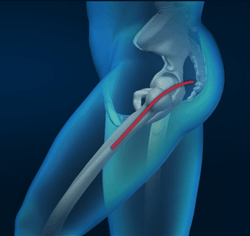
What is Posterior Hip Replacement?
Posterior hip replacement is a minimally invasive hip surgery performed to replace the hip joint.
The posterior approach is traditionally the most common approach used to perform a total hip replacement. In a posterior hip replacement, the surgeon makes the hip incision at the back of the hip close to the buttocks. The incision is placed so the abductor muscles (gluteus medius and minimus), the major walking muscles, are not cut.
Indications
Hip replacement is indicated in patients with arthritis of the hip joint. Arthritis is a condition in which the articular cartilage that covers the joint surface is damaged or worn out causing pain and inflammation. Some of the causes of arthritis include:
- Advancing age
- Congenital or developmental hip diseases
- Obesity
- Previous history of hip injury or fracture
- Increased stress on hip because of overuse
Symptoms
Patients with arthritis have a thinner articular cartilage lining, a narrowed joint space, presence of bone spurs or excessive bone growth around the edges of the hip joint. Because of all these factors arthritis patients can experience pain, stiffness, and restricted movements.
Diagnosis
Dr. McNabb will talk with you about your hip symptoms and treatments you have tried, perform a physical examination, and typically order X-rays.
Procedure of Posterior Hip Replacement
Posterior hip replacement surgery involves the following steps:
- The procedure is typically performed under spinal anesthesia.
- You are positioned on your side on the operating table.
- An incision is on the side of your hip close to your buttocks.
- Muscles and tendons are separated to gain access to the hip joint.
- The thigh bone or femur is dislocated from the hip socket, acetabulum.
- The damaged femoral head is removed.
- The acetabular surface is then prepared and the acetabular component of the prosthesis is inserted.
- A liner made of plastic is placed inside the acetabular component to provide a smooth, gliding surface.
- The femoral bone is prepared to receive the femoral component.
- Then the new femoral component is inserted into the femur bone and the femoral head component is placed on the stem.
- Once the artificial components are fixed in place, the hip is relocated and taken through a range of motion to verify stability.
- The instruments are withdrawn, soft tissues are re-approximated, and the incision is closed and covered with a sterile dressing.
Risks and Complications
All surgeries carry an element of risk whether it is related to the anesthesia or the procedure itself. Risks and complications are rare but can occur. Below is a list of complications that can occur following any hip replacement procedure:
- Dislocation
- Infection at the incision site or in the joint space
- Fracture
- Nerve damage
- Hemarthrosis: excess bleeding into the joint after the surgery.
- Deep vein thrombosis (blood clot) or pulmonary embolisis (blood clot in the lung)
- Leg length inequality
- Continued pain
Post-operative Care
After posterior hip replacement surgery, you will be instructed to follow certain hip precautions to prevent your new hip from dislocating.
- Avoid the combined movement of bending your hip past 90 degrees
- Keep a pillow between your legs while sleeping for 6 weeks
- Do not cross your legs
- Avoid sitting on a low chair to avoid excessive flexion of your hip
- Avoid getting the foot of your operated leg too far behind you
- Based on bone quality you may also be asked to limit your weight on your revised hip
Your doctor will also give you other instructions to follow at home for a faster recovery. These include:
- Take medications as prescribed to relieve pain.
- Participate in physical therapy to restore hip function and strength.
- Eat a healthy diet and do not smoke to facilitate healing and promote a faster recovery.
- Contact your doctor if you observe increasing swelling or redness in the operated area.






